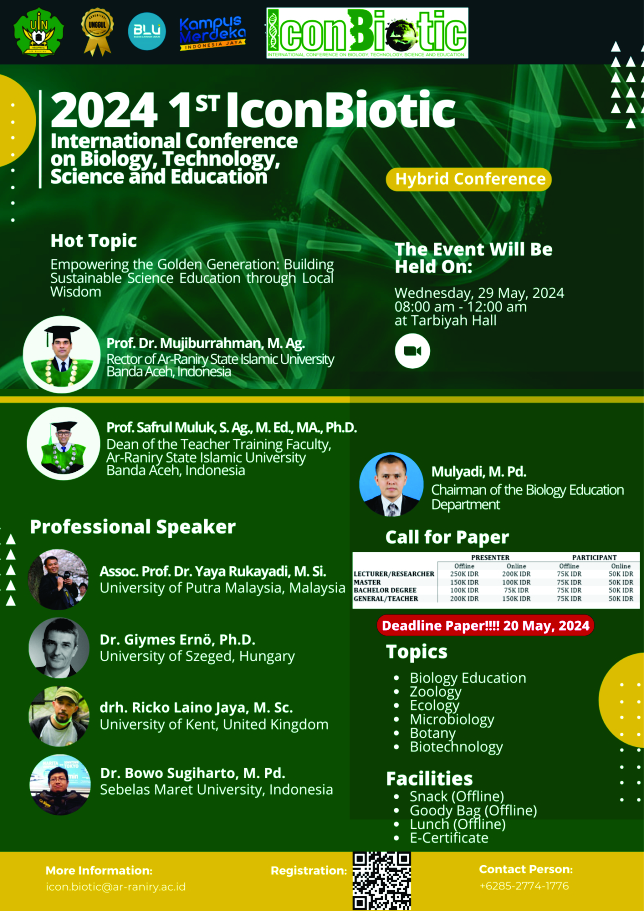THE BIOLARVICIDAL EFFECTIVENESS OF AVOCADO SEED ETHANOL EXTRACT IN GRANULE FORM ON HIGHEST MORTALITY PERCENTAGE WITH LETHAL TIME
Keywords:
Dengue Hemorrhagic Fever, Aedes aegypti, Biolarvicide, Lethal Time, Persea americana Mill.Abstract
Dengue Hemorrhagic Fever (DHF) cases have increased along with climate change. This can be a threat to society, the death rate has reached 1.237 out of 143.266 cases of dengue fever in 2022. Control of larvae is important to prevent their growth into vectors. The use of chemical larvicides has been studied and shows resistance in larvae. This problem encourages us to eradicate Aedes aegypti larvae by identifying potential compounds in avocado (Persea americana Mill.) seed as one of most potential commodities in Aceh. This study is an experimental study that aims to determine the biolarvicide potential of ethanol extract in granule form against Ae. Aegypti larvae with multigrade 12.5%, 25% and 50% concentrations of extract. This study used a Completely Randomized Design that analyzed by linear regression and probit LT 50 and LT 95. The results showed the highest percentage of mortality at a concentration of 25% which resulted in 50,6% larval mortality. The estimated lethal time value at 25% concentration is LT50 = 311.112801 and LT95 = 500.379746 which means it takes ±12 hours to kill 50% of 75 larvae and ±20 hours to kill 95% of larvae.
References
Abubakar, Y., Tijjani, H., Egbuna, C., Adetunji, C. O., Kala, S., Kryeziu, T. L., & Patrick-Iwuanyanwu, K. C. (2019). Pesticides, history, and classification. Natural Remedies for Pest, Disease and Weed Control, January, 29–42. https://doi.org/10.1016/B978-0-12-819304-4.00003-8
Balachandran, C., Anbalagan, S., Kandeepan, C., Arun Nagendran, N., Jayakumar, M., Fathi Abd_Allah, E., Alqarawi, A. A., Hashem, A., & Baskar, K. (2021). Molecular docking studies of natural alkaloids as acetylcholinesterase (AChE1) inhibitors in Aedes aegypti. Journal of Asia-Pacific Entomology, 24(3), 645–652. https://doi.org/10.1016/j.aspen.2021.05.011
Kemenkes RI. (2022). Profil Kesehatan Indonesia 2021. In Pusdatin.Kemenkes.Go.Id.
Rezza, G. (2012). Aedes albopictus and the reemergence of Dengue. BMC Public Health, 12(1), 72. https://doi.org/10.1186/1471-2458-12-72
Rohmah, E. A., Subekti, S., & Rudyanto, M. (2020). Larvicidal Activity and Histopathological Effect of Averrhoa bilimbi Fruit Extract on Aedes aegypti from Surabaya, Indonesia. Journal of Parasitology Research, 2020. https://doi.org/10.1155/2020/8866373
Silalahi, C. N., Tu, W. C., Chang, N. T., Singham, G. V., Ahmad, I., & Neoh, K. B. (2022). Insecticide Resistance Profiles and Synergism of Field Aedes aegypti from Indonesia. PLoS Neglected Tropical Diseases, 16(6), 1–13. https://doi.org/10.1371/JOURNAL.PNTD.0010501
Susanti, L., & Boesri, H. (2012). Insektisida Sipermethrin 100 G/L Terhadap Nyamuk Dengan Metode Pengasapan. KESMAS - Jurnal Kesehatan Masyarakat, 7(2), 156–163. https://doi.org/10.15294/kemas.v7i2.2812
Utami, A. W., & Porusia, M. (2023). Kajian Literatur Pengaruh Insektisida Nabati Dan Insektisida Sintetik Terhadap Kematian Larva Nyamuk Aedes Aegypti. Jurnal Kesehatan Masyarakat, 11(2), 168–189. https://doi.org/10.14710/jkm.v11i2.37721
World Health Organization. (2011). Comprehensive Guidelines for Prevention and control of dengue and dengue haemorrhagic fever. Regional Guidelines. In World Health Organization. https://apps.who.int/iris/handle/10665/204894
Zulfa, R., Lo, W. C., Cheng, P. C., Martini, M., & Chuang, T. W. (2022). Updating the Insecticide Resistance Status of Aedes aegypti and Aedes albopictus in Asia: A Systematic Review and Meta-Analysis. Tropical Medicine and Infectious Disease, 7(10). https://doi.org/10.3390/tropicalmed7100306


















